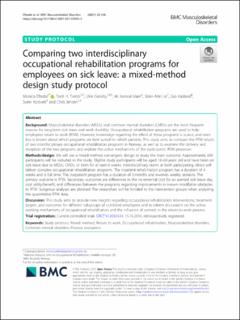| dc.contributor.author | Eftedal, Monica | |
| dc.contributor.author | Tveito, Torill Helene | |
| dc.contributor.author | Gensby, Ulrik | |
| dc.contributor.author | Islam, Kamrul | |
| dc.contributor.author | Lie, Stein Atle | |
| dc.contributor.author | Aasland, Gro E. | |
| dc.contributor.author | Kostveit, Svein | |
| dc.contributor.author | Jensen, Chris | |
| dc.date.accessioned | 2022-02-08T13:53:01Z | |
| dc.date.available | 2022-02-08T13:53:01Z | |
| dc.date.created | 2021-02-09T22:54:00Z | |
| dc.date.issued | 2021 | |
| dc.identifier.issn | 1471-2474 | |
| dc.identifier.uri | https://hdl.handle.net/11250/2977751 | |
| dc.description.abstract | Background
Musculoskeletal disorders (MSDs) and common mental disorders (CMDs) are the most frequent reasons for long-term sick leave and work disability. Occupational rehabilitation programs are used to help employees return to work (RTW). However, knowledge regarding the effect of these programs is scarce, and even less is known about which programs are best suited for which patients. This study aims to compare the RTW results of two interdisciplinary occupational rehabilitation programs in Norway, as well as to examine the delivery and reception of the two programs and explore the active mechanisms of the participants’ RTW processes.
Methods/design
We will use a mixed-method convergent design to study the main outcome. Approximately 600 participants will be included in the study. Eligible study participants will be aged 18–60 years old and have been on sick leave due to MSDs, CMDs, or both for at least 6 weeks. Interdisciplinary teams at both participating clinics will deliver complex occupational rehabilitation programs. The inpatient rehabilitation program has a duration of 4 weeks and is full time. The outpatient program has a duration of 3 months and involves weekly sessions. The primary outcome is RTW. Secondary outcomes are differences in the incremental cost for an averted sick leave day, cost utility/benefit, and differences between the programs regarding improvements in known modifiable obstacles to RTW. Subgroup analyses are planned. The researchers will be blinded to the intervention groups when analyzing the quantitative RTW data.
Discussion
This study aims to provide new insights regarding occupational rehabilitation interventions, treatment targets, and outcomes for different subgroups of sick-listed employees and to inform discussions on the active working mechanisms of occupational rehabilitation and the influence of context in the return-to-work process. | en_US |
| dc.language.iso | eng | en_US |
| dc.publisher | BMC | en_US |
| dc.rights | Navngivelse 4.0 Internasjonal | * |
| dc.rights.uri | http://creativecommons.org/licenses/by/4.0/deed.no | * |
| dc.title | Comparing two interdisciplinary occupational rehabilitation programs for employees on sick leave: a mixed-method design study protocol | en_US |
| dc.type | Journal article | en_US |
| dc.type | Peer reviewed | en_US |
| dc.description.version | publishedVersion | en_US |
| dc.rights.holder | Copyright The Author(s), 2021 | en_US |
| dc.source.articlenumber | 158 | en_US |
| cristin.ispublished | true | |
| cristin.fulltext | original | |
| cristin.qualitycode | 1 | |
| dc.identifier.doi | 10.1186/s12891-021-03994-3 | |
| dc.identifier.cristin | 1888301 | |
| dc.source.journal | BMC Musculoskeletal Disorders | en_US |
| dc.identifier.citation | BMC Musculoskeletal Disorders. 2021, 22, 158. | en_US |
| dc.source.volume | 22 | en_US |

